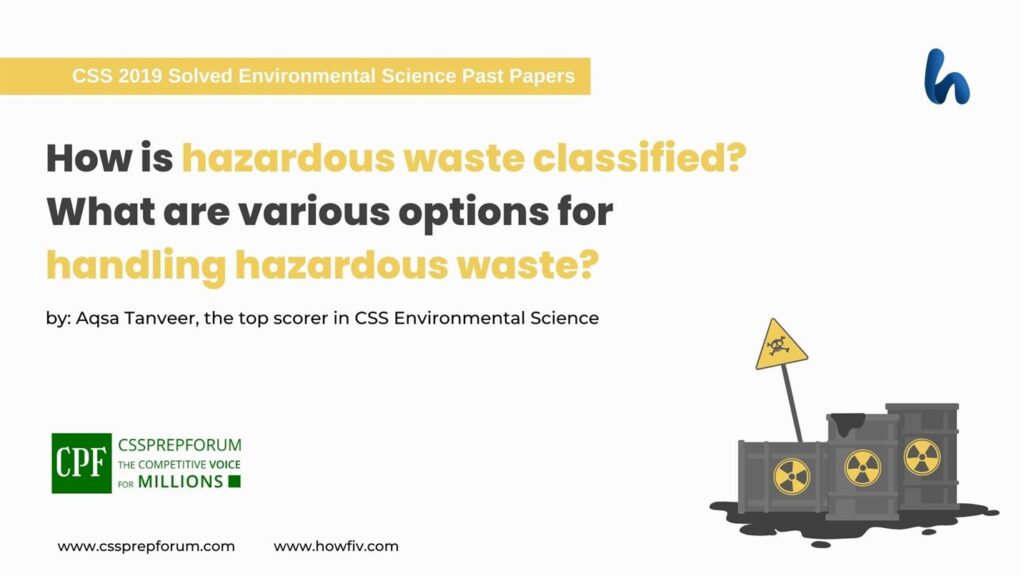CSS Solved Environmental Science 2019 Past Paper | How is hazardous waste classified? What are various options for handling hazardous waste?
Aqsa Tanveer, the highest scorer in the CSS Environmental Science paper, attempts the following question. The answer is written on the same pattern, taught by Sir to his students, scoring the highest marks in compulsory subjects for years. This solved past paper question is uploaded to help aspirants understand how to crack a topic or question, how to write relevantly, what coherence is, and how to include and connect ideas, opinions, and suggestions to score the maximum.

Question Breakdown
In this question requirement of the examiner revolves around two domains. First and foremost is a classification of hazardous waste and then available methods to handle the hazardous waste. For a better interpretation of the question, an inclusive and appropriate outline is mandatory. You have to begin with an introduction and a quick glance at the concept of hazardous waste. In order to address the first part of the question, standard classification and categorization of hazardous waste should be given along with its manifestations. Moreover, you have to illustrate the most effective strategies and methods to handle hazardous waste. As a way forward, you have to embark on principles of integrated sustainable management. For the sake of value addition, diagrams and flow charts can play an effective role. In order to put the whole question in a nutshell, an adequate conclusion must be given at the end.
Outline
1- Introduction
2- A glance at concept of hazardous waste
3- Classification of solid wastes
- ✓Non-hazardous waste
- ✓Hazardous waste
4- Classification of hazardous waste according to EPA:
- ✓F-List
- ✓K-List
- ✓P-List
- ✓U-List
5- Categories of hazardous wastes
- ✓Radioactive substance
- ✓Chemicals
- ✓Bio-medical wastes
- ✓Flammable wastes
- ✓Explosives
6- Characteristics of hazardous waste
- ✓Ignitability
- ✓Corrosivity
- ✓Reactivity
- ✓Toxicity
7- Strategies for management of hazardous waste
- ✓Handling of hazardous wastes
- ✓Transport of hazardous waste
- ✓Disposal
- Secure landfill
- Deep well disposal
- Bedrock disposal
8- Principles of integrated sustainable waste management: a way forward
- ✓Equity
- ✓Effectiveness
- ✓Efficiency
- ✓Sustainability
9- Conclusion

Introduction
In recent decades due to population explosion, industrialization and rapid urbanization, waste management has become a significant environmental problem. It inculcates both non-hazardous and hazardous waste. Non-hazardous waste poses no potential threat to the environment, but hazardous waste substantially threatens the environment and human health. So far, rapid industrialization has contributed a major chunk of dangerous waste material, including solids, liquids and gases. Henceforth, in order to minimize environmental hazards, governments and international agencies, along with environmentalists and public health managers, are paying heed to proper storage, segregation, transportation and disposal of hazardous waste. In modern society, rapid industrialization is inevitable; therefore, hazardous waste production is an unavoidable outcome. When hazardous waste is disposed of directly into the environment without proper management, it causes potential damage to the environment. These substances are non-biodegradable and tenacious in their respective environment; henceforth, they cause human health and natural resources deterioration.
‘‘Environmental problems begin with people as the cause and end with people as the victim.’’
The process of hazardous waste management comprises collection, recycling, treatment, transportation, disposal, and monitoring of waste disposal sites. Chemicals from hazardous waste, including, carcinogens, toxic agents, irritants and corrosives from various sources, not only contaminate the land, air, and water but also damage the hematopoietic system of human beings. The substantial risk to human health associated with these chemicals ranges from short-term problems, such as headaches and nausea, to long-term chronic health issues, such as cancers and congenital defects. Moreover, chemicals from hazardous waste such as explosives and flammable, reactive, oxidizers can release vapours, fumes, smoke and mists which are damaging to the respective environment. Henceforth, it is vital to take immediate eco-friendly and economically viable steps for managing hazardous waste. Keeping in view, the grave concerns associated with hazardous waste succeeding paragraphs demonstrate classification, characteristics, principles and viable options for the management of hazardous waste.
Classification of Solid Wastes
- ✓ Non-hazardous waste
Non-Hazardous waste is a type of waste that causes no harm to the environment and human health.
- ✓Hazardous waste
Hazardous waste is waste that is deteriorating human health and the environment. It includes liquids, solids and gases such as sanitisers, fertilizers, detergents and pesticides.
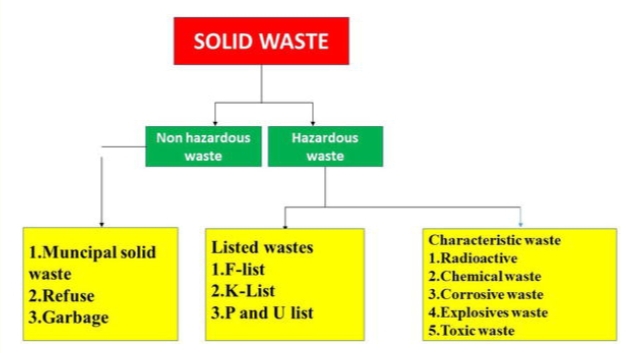
Classification of Hazardous Wastes
EPA has classified hazardous waste into the following categories:
- ✓ F-list
This list inculcates hazardous waste produced from nonspecific sources. The manufacturing processes in industries are the major contributors to the generation of these wastes. The solvent used in the treatment of metals, water formed in the metal treatment process, and dioxin produces from chemicals.
Based on manufacturing processes in industries, there are the following categories of industrial wastes:
- Solvent waste
- Metal treatment waste
- Dioxins
- Hydrocarbons
- Waste generated during Wood preservation
- petroleum refinery wastes
- leachate
- ✓ K-list
This list inculcates hazardous waste produced from specific sources. The manufacturing processes in industries are the major contributors to the generation of these wastes.
Based on manufacturing processes in industries, there are the following categories of industrial wastes:
- Production of Organic chemicals
- Pesticides
- Production of pharmaceuticals
- Production of Inorganic chemicals
- Manufacturing Explosives
- Iron and steel manufacturing process
- Production of aluminium
- Processing of lead
- Ink formulation
- Coal production
- ✓ P and U lists
The hazardous waste that comes under P and U lists are those chemicals disposed of unused. This waste has the following categories:
- The waste must contain those chemicals that are listed in the respective list
- The chemical in hazardous waste must be unused
Categories of Hazardous Wastes
- ✓ Radioactive substance
Radioactive waste is a by-product of nuclear processes, nuclear medicine production, nuclear research, nuclear power and the processing of atomic weapons. It contains radioactive material, which releases harmful ionizing radiation; long time exposure leads to the deterioration of living organisms’ health. The disposal of radioactive substances depends upon their half-life. For example, uranium has a half-life range from 72 years to 23,420,000.
- ✓ Chemicals
The hazardous chemicals are divided into various categories, such as synthetic organic compounds, inorganic metals, acids, bases, salts and explosives. These chemicals are hazardous to human health.
- ✓ Bio-medical wastes
The most common sources of hazardous waste are biological wastes from hospitals and research setups. This type of waste can cause infections and can produce toxins. It includes primarily contaminated materials, such as needles, bandages and expired drugs.
- ✓ Flammable wastes
The risk involved in this category is associated with the storage, collecting and disposal of flammable wastes. For instance, it includes solvents, oils and plastics.
- ✓ Explosives
Explosives are also associated with substantial risk while storing, collecting and disposal.
Characteristics of Hazardous Waste
- ✓ Ignitability
A waste that creates fire under certain conditions if its flash point is less than 60°C is spontaneously combustible such as ignitable compressed gas. For instance, epoxy resins, adhesives and oil paints, to mention a few.
- ✓ Corrosivity
Liquid wastes whose pH is less than two or greater than 12.5 fall under the category of corrosive hazardous waste. For instance, sodium hydroxide (High pH) and hydrochloric acid (Low pH) are mostly used in many industries for metal treatment.
- ✓ Reactivity
If a material is unstable under normal conditions, it reacts immediately, generates toxic fume when mixed with water and explodes in heat. For instance, gunpowder, sodium metal, cyanides
- ✓ Toxicity
By taking a sample in a certified laboratory of given material toxicity of hazardous waste can be determined. It can cause death or potential harm when inhaled, swallowed or absorbed.
Methods of hazardous waste management
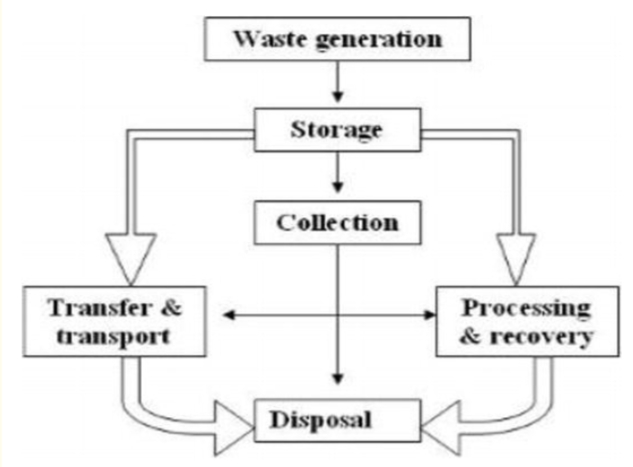
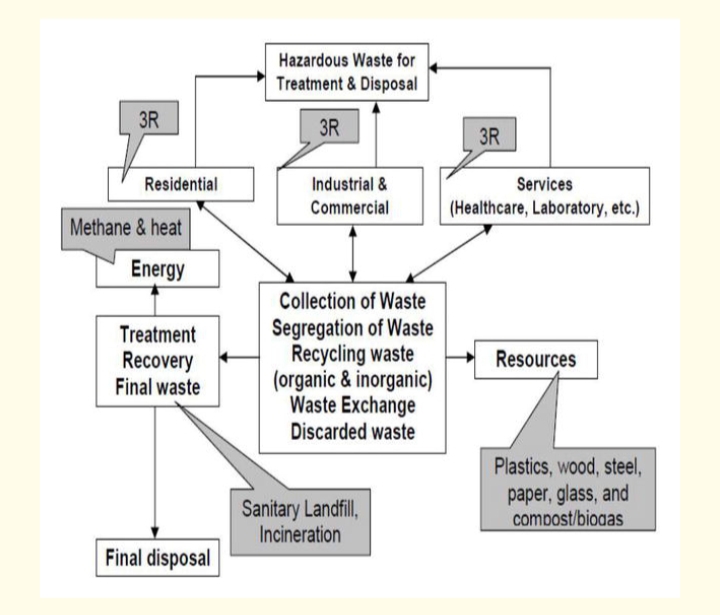
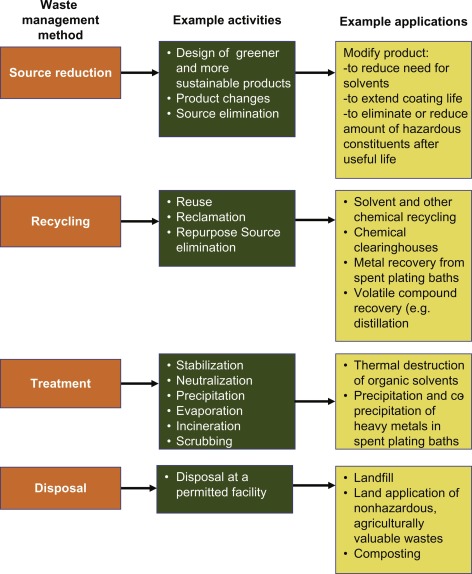
- ✓ Handling of hazardous wastes
Persons handling hazardous wastes mostly follow standard operating procedures as a precautionary measure to protect themselves from health effects. Abnormal exposure to such waste can lead to skin dermatitis, lung asthma on long exposure and irritation of the eyes.
- ✓ Transport of hazardous waste
The waste generated requires adequate transport to the appropriate site for treatment purposes, then storage and proper disposal. There is a substantial threat to human health and the respective environment. Governmental agencies mostly pay significant attention to transport to avoid accidental spills.
- ✓ Disposal
The final stage of hazardous waste management is the appropriate disposal of hazardous waste. Various waste disposal options include secure landfill, deep well and bedrock disposal.
a. Secure landfill
Hazardous Wastes are categorized into recyclable, incinerable, and disposable. A landfill is a disposal area where hazardous waste is mainly stored in the soil. Hazardous waste mostly enters natural hydrologic systems when disposed of in landfills because inadequate disposal results in the seeping of material into the ground. To prevent the chemicals from entering the soil, a barrier is required, and this process depends upon the category of hazardous waste. For instance, an appropriate design of landfill is shown in the Figure below

The main components in the leachate from landfill sites are
- Elements and ions include calcium, magnesium, iron, sodium, ammonia, carbonate and chloride.
- Metals traces such as manganese, chromium, nickel, lead and calcium
- Organic compounds
b. Deep well disposal
In this method, the disposal of liquid industrial waste is carried out by injecting it into the deep well, as shown in the figure below. Untreated liquid waste is mostly placed into geologic formations under high pressure that does not allow the spilling of contaminants into natural water aquifers. It is a cost-effective process, but there is the danger of leaking hazardous waste and water pollution.

c. Bedrock disposal
Various bedrocks serve as host rocks for the disposal of hazardous waste. The design of a bedrock disposal site or repository for hazardous wastes is shown in the figure given below

Principles of Integrated Sustainable Waste Management
Integrated sustainable waste management is an appropriate option for the application of techniques, technologies and approaches and attaining goals. This system makes sure coordination of all systems for rational planning and implementation. It consists of the following basic principles:
- ✓ Equity
Exposure to appropriate waste management systems should need base for all citizens to maintain environmental and human health.
- ✓ Effectiveness
Removal of waste should be safe through the waste management system.
- ✓ Efficiency
The primary concern of waste management is to maximize the benefits, lower the costs, and optimize the use of resources, taking into account equity, effectiveness and sustainability.
- ✓ Sustainability
The waste management system should be technically viable and environmentally sustainable. The role of social, economic, financial and political institutions should be inclusive without exhausting the existing resources.
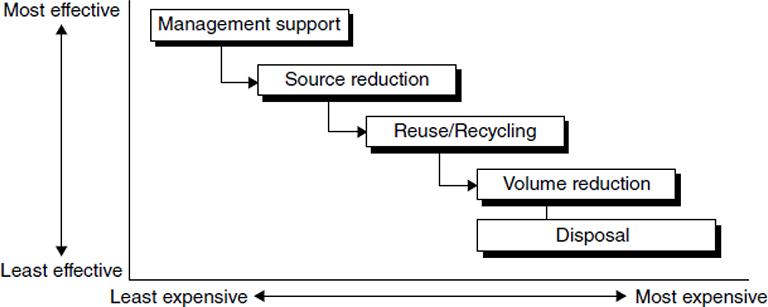
Conclusion
To sum up, the main objective of hazardous waste management programs is to change the conventional mindset of managing waste so that it can be stored, transported and disposed of in a sustainable, desirable and viable way for the sake of environmental and human health. The goal of managing hazardous waste falls under the domain of public health managers, environmentalists, and governmental organizations. Adequate hazardous waste management can help to minimize land, water and air pollution. Therefore, it is need of the hour to direct industrialists to generate a minimum amount of hazardous waste during manufacturing processes. The most viable options in this regard are recycling and effective waste treatment. Henceforth, modern society can utilize modern technology to prevent the destruction of environmental and human health.
‘‘If it can be reduced, reused, rebuilt, recycled, then it should be restricted, redesigned or removed from production’’
CSS Solved Past Papers’ Essays
Looking for the last ten years of CSS and PMS Solved Essays and want to know how Sir Kazim’s students write and score the highest marks in the essays’ papers? Then, click on the CSS Solved Essays to start reading them.
CSS Solved Essays

CSS Solved General Science & Ability Past Papers
Want to read the last ten years’ General Science & Ability Solved Past Papers to learn how to attempt them and to score high? Let’s click on the link below to read them all freely. All past papers have been solved by Miss Iqra Ali & Dr Nishat Baloch, Pakistan’s top CSS GSA coach having the highest score of their students.
General Science & Ability Solved Past Papers
CSS Solved Pakistan Affairs Past Papers
Want to read CSS Pakistan Affairs Solved Past Papers and learn how to attempt them to score high? Let’s click on the link below to read them all freely. All past papers’ questions have been attempted by Sir Kazim’s students, who scored the highest in the subject.
CSS Solved Pakistan Affairs
CSS Solved International Relations’ Past Papers
Have you opted for International Relations in the CSS examination and want to score above 150? Then, click on the CSS Solved International Relations’ Past Papers by Miss Abeera Fatima, the top IR scorer and the best IR coach in Pakistan.
CSS Solved International Relations Past Papers
Articles Might Interest You!
The following are some of the most important articles for CSS and PMS aspirants. Click on any to start reading.

